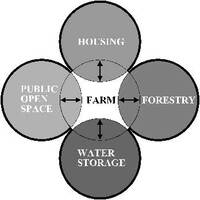- England
- Scotland
- France
- Holland
- Germany
- Italy
- Spain
- Portugal
- USA
- China
- Japan
- India
- Iran
- Advice
- Gardens
- England
- Scotland
- France
- Holland
- Germany
- Italy
- Spain
- Portugal
- USA
- China
- Japan
- India
- Iran
- Advice
- Garden Tours
Book: Landscape Planning and Environmental Impact Design: from EIA to EID
Chapter: Chapter 7 Agriculture, farming and countryside policy
All-public and all-private are equally bad.
Agriculture is the predominant human use of the Earth's land surface. It always has been and, one assumes, it always will be. Primitive agriculture may have operated without community involvement. Organised agriculture, to be efficient, requires good access roads, irrigation systems, drainage channels and protective measures against floods and infectious diseases. These are best obtained from a mix of public and private endeavour. The difficulty is in deciding what is best achieved by public action and what should be left to markets. The 1930s remind us that either an all-public system, like that used in the Soviet Empire, or an all-private system, like that used in the USA, can be disastrous. The Soviet system resulted in starvation, in the 1930's, while the American system was causing near-starvation and the Dust Bowl. A mixed economy has significant advantages for both public goods and agricultural goods. Rivers and roads are useful examples of rural public goods. Both are linear features which confer benefits on the public; both can be privately owned. The distinction is that roads are man-made and rivers are works of nature. Human labour may command a wage, paid from the public purse. Natural assets may command a rent, paid from the public purse. Rural land has characteristics which are part man-made and part-natural. Other examples of public goods will be discussed below: a strategic capacity to produce extra food in times of crisis; wildlife conservation; water conservation; scenic conservation; historic conservation; outdoor recreation; a supply of non-farmed food. Two points should be borne in mind: -in 1995, the European Union spent ,95 billion on agricultural support (Farmers Weekly, 1995) -the citizens of Europe should demand maximal public benefit from public expenditure on agriculture Food production should not be a single-minded exclusive land use. Imaginative EID can enable food to be produced in concert with other objectives and other land uses [Fig 7.3] 7.3 Food production can take place in co-operation with other land uses
